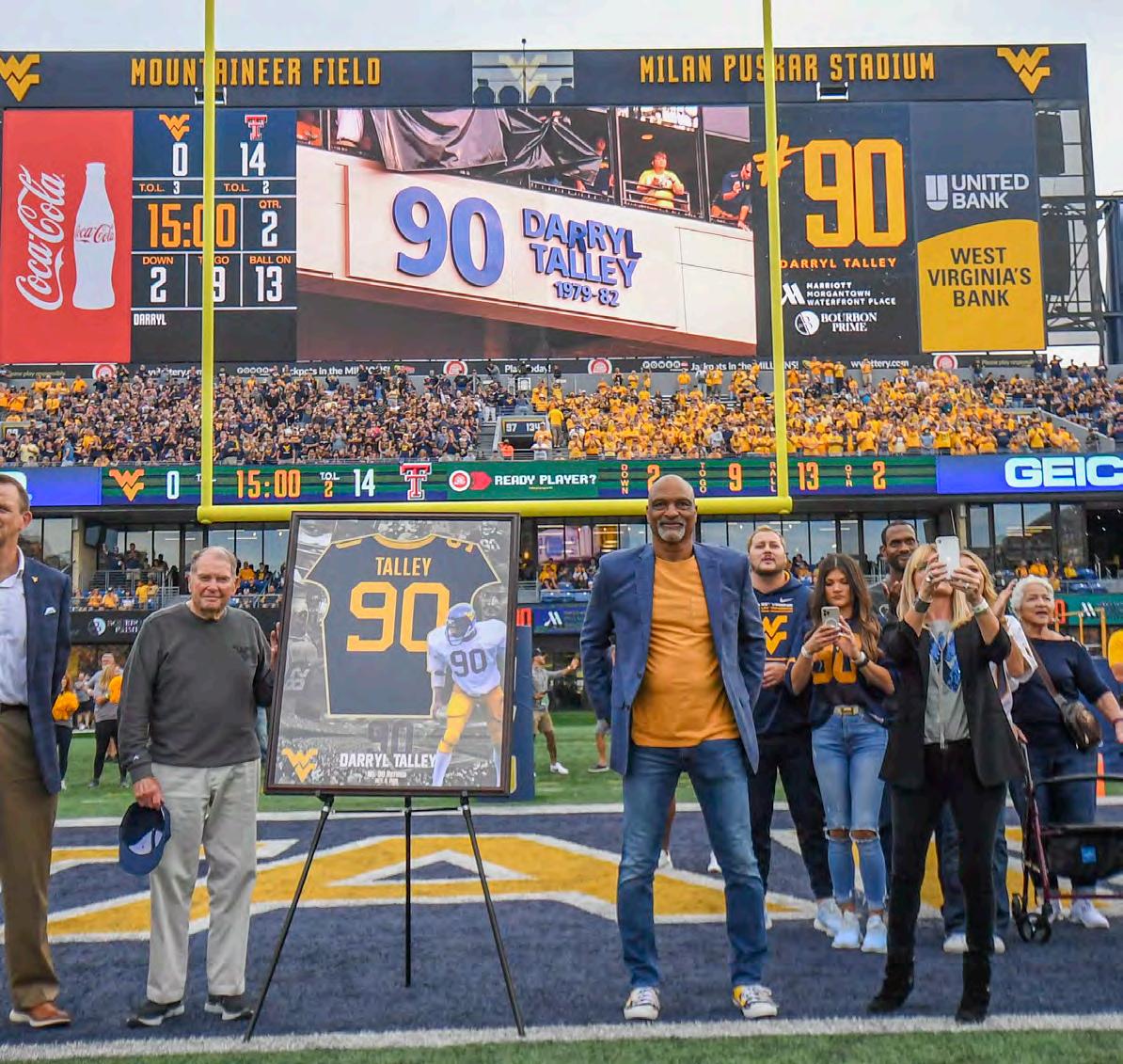
3 minute read
Harris and Talley Immortalized With Number Retirements
West Virginia University football legends Major Harris and Darryl Talley joined the pantheon of Mountaineer football greats this past fall with the retirement of their numbers, becoming just the fourth and fifth Mountaineer gridders (No. 75 Sam Huff, No. 21 Ira Errett Rodgers and No. 77 Bruce Bosley) to be so honored.
Talley, who wore No. 90, was a four-year starter who culminated his career with consensus All-America honors in 1982. That was just part of a magnificent career for the East Cleveland, Ohio, native who had five tackles for loss against Penn State in 1980, was Sports Illustrated’s National Player of the Week after a win against Boston College in 1982 and finished his career as WVU’s career tackles leader with 484 (282 solo) with 35 tackles for loss, 19 sacks, five interceptions and five fumble recoveries.
Advertisement
More importantly though, he was a big part of the foundation on which Don Nehlen rebuilt the Mountaineer football program.
The Buffalo Bills drafted him in the second round of the 1983 NFL Draft, and he blossomed into a star for the Bills, playing 12 seasons as the team’s starting outside linebacker from 198394, never missing a game and starting in four straight Super Bowls. At the conclusion of his career, Talley was the Bills’ all-time leading tackler with 1,137. He also recorded 38½ sacks, 12 interceptions, 14 fumble recoveries and three touchdowns for his career as a Bill, averaging 120 tackles, 3½ sacks and 6.2 takeaways per season.
Aside from the Super Bowls, he was selected twice to the Pro Bowl and was voted All-Pro in 1990 and 1991. He concluded his career by playing one season each with the Atlanta Falcons and Minnesota Vikings to total 14 years in the NFL.
Talley’s overall career honors are vast. He is a member of WVU’s AllTime Football Team, was inducted into the WVU Sports Hall of Fame in 1996, won the Ralph C. Wilson, Jr. Distinguished Service Award in 2000, which is named after the Bills’ legendary owner, became the 20th member of the Buffalo Bills’ Wall of Fame, inducted into the College Football Hall of Fame in 2011, the Mountaineer Legends Society in 2016 and named one of the 26 greatest players in Buffalo Bills history as part of the team’s 50th Anniversary, joining teammates Jim Kelly, Bruce Smith, Thurman Thomas, Cornelius Bennett and Andre Reed among others.
Harris, a native of Pittsburgh, wore No. 9 for three of the most exciting seasons in school history. His wrongway touchdown run that served as a catalyst in a 51-30 beating of Penn State in 1988 was THE highlight in a career full of them from 1987-89.
The trailblazing Harris was one of college football’s most exciting performers in the late 1980s, but not only was he a remarkable athlete with futuristic skills on the football field, he also possessed an effervescent and magnetic personality off it, and he arrived at the same time ESPN was transforming college football into one
of America’s most popular sports. It could easily be said that his style of play was ahead of its time and paved the way for future quarterbacks such as Michael Vick, Russell Wilson, Lamar Jackson, Patrick Mahomes and many stars of today to shine in the NFL.
How popular was Major? Consider this: the ONLY two seasons West Virginia football has ever averaged more than 60,000 fans per game occurred during Major’s sophomore and junior seasons in 1988 and 1989. And five of the 17 largest crowds in Mountaineer Field history still involve games in which Harris played.
Arriving in Morgantown at a time when West Virginia was coming off two straight seasons without going to a bowl game, Harris ignited a flame in the Mountaineer grid program that led to the doorstep of a national championship and turned the Mountaineers from a regional football program into a national one after the first unbeaten, untied regular season in school history (1988). He had a pair of top-five Heisman Trophy finishes (5th in 1988 and 3rd in 1989), became the first quarterback in NCAA history to rush for 2,000 yards and pass for 5,000, received write-in votes for governor of the state of West Virginia (1988), was a First Team Kodak AllAmerican (1989) and two-time ECAC Player of the Year (1988 and ’89), was inducted into the WVU Sports Hall of Fame (1999), the College Football Hall of Fame (2010) and Mountaineer Legends Society (2016).











